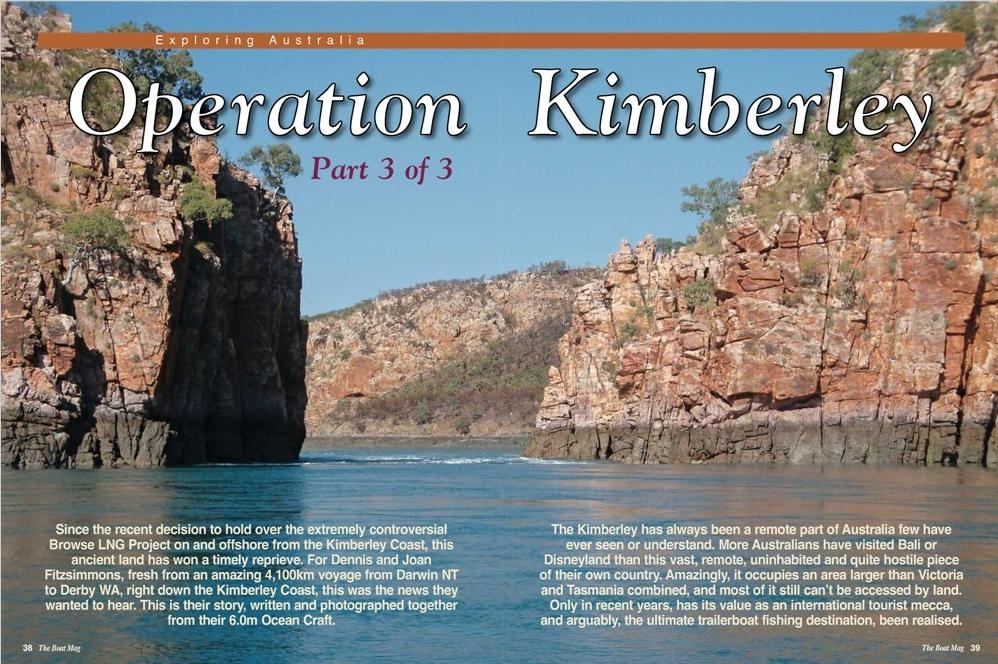
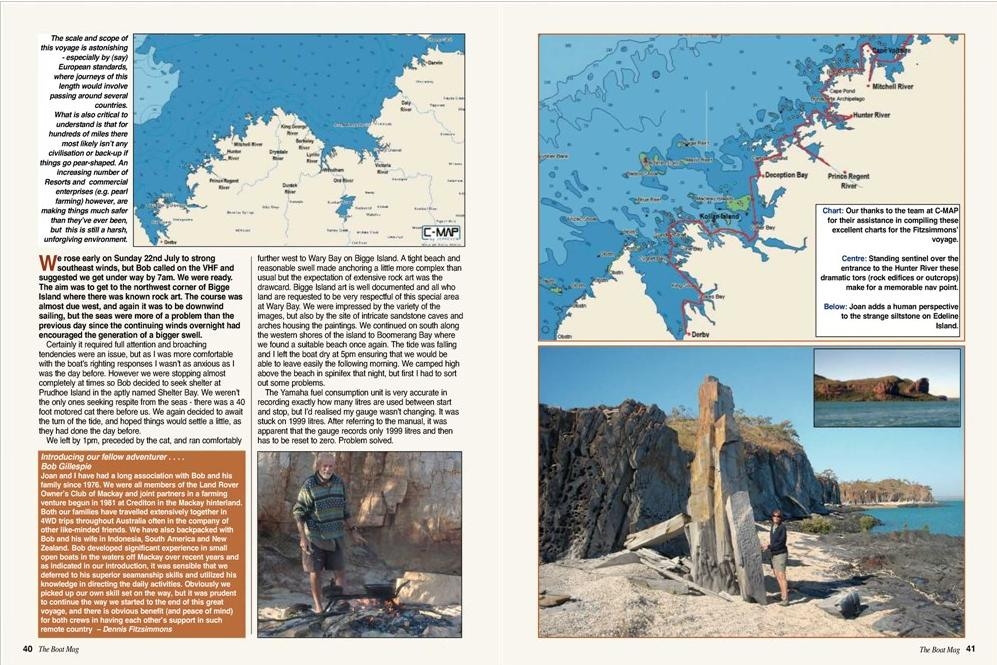
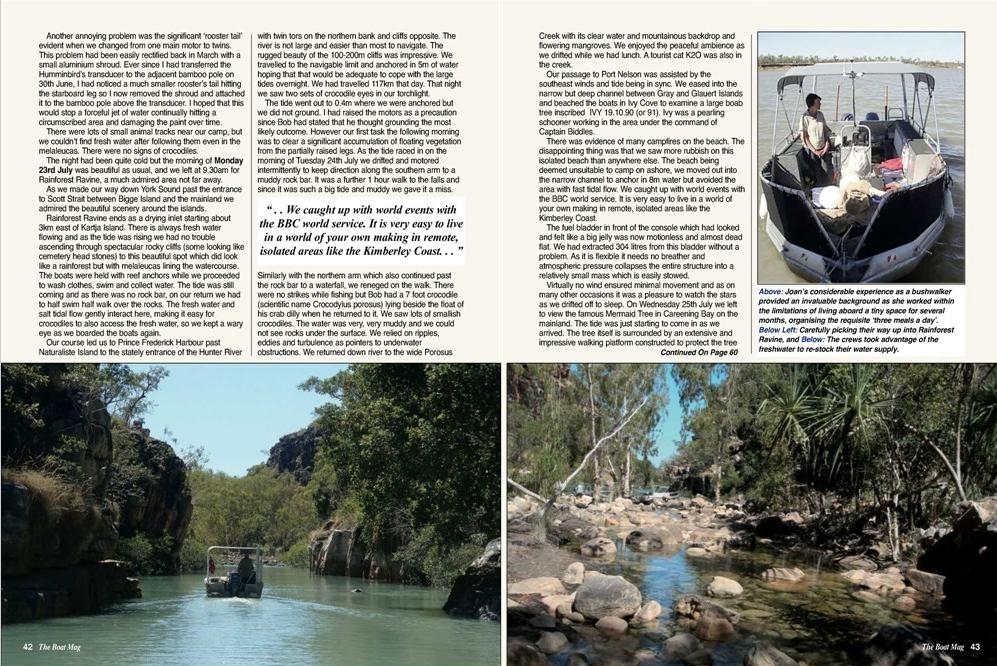
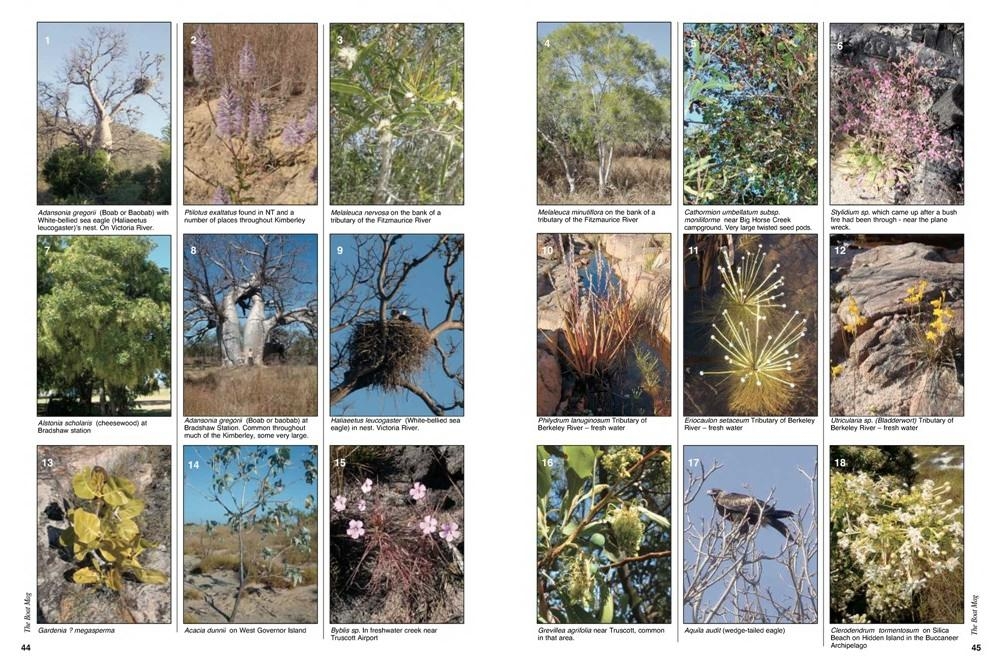
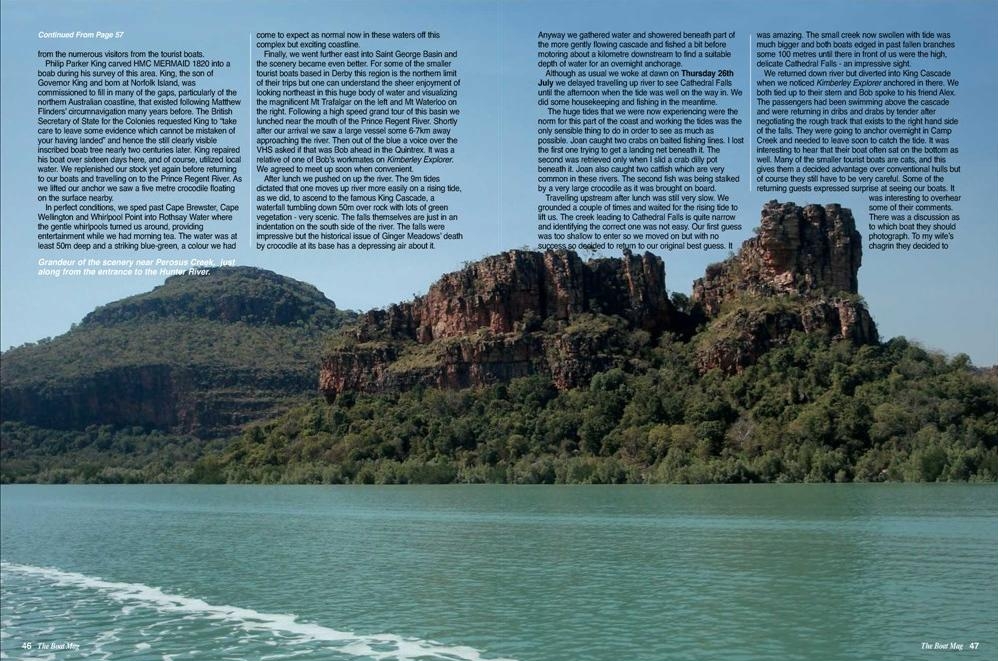
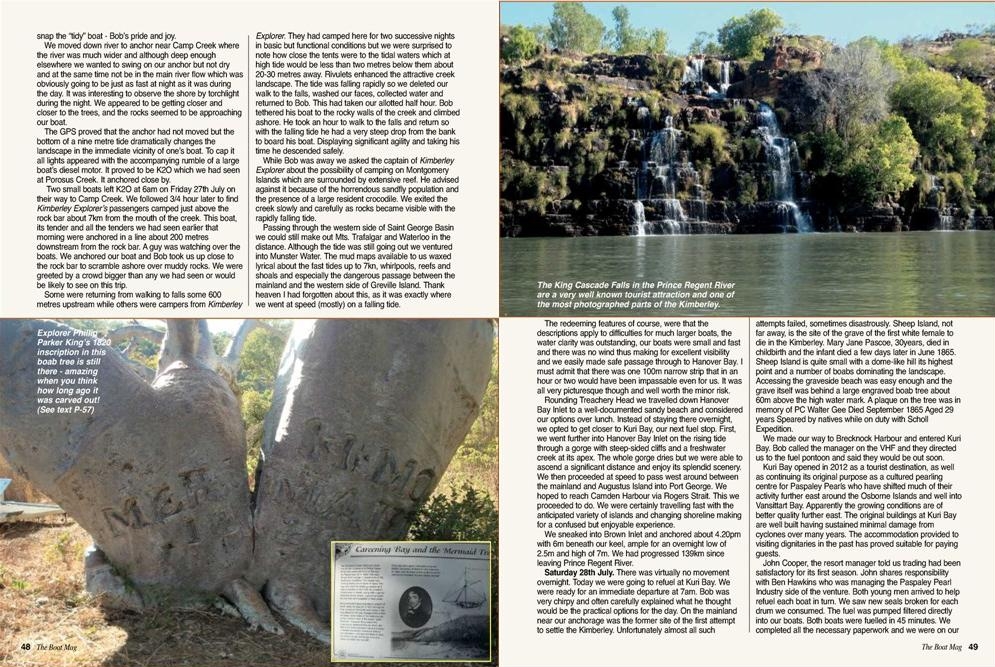
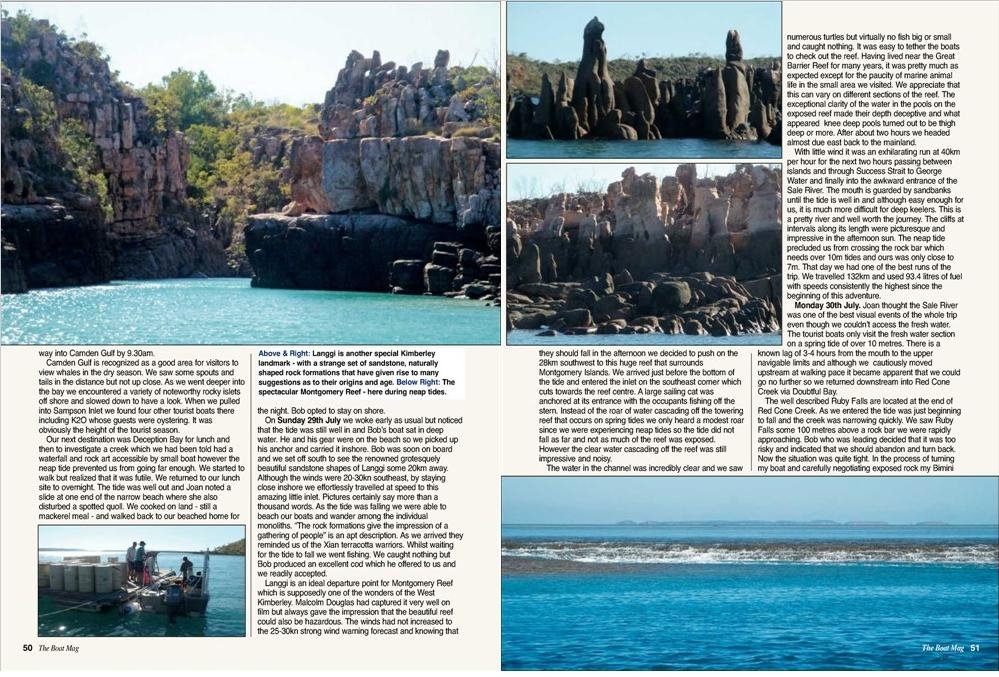
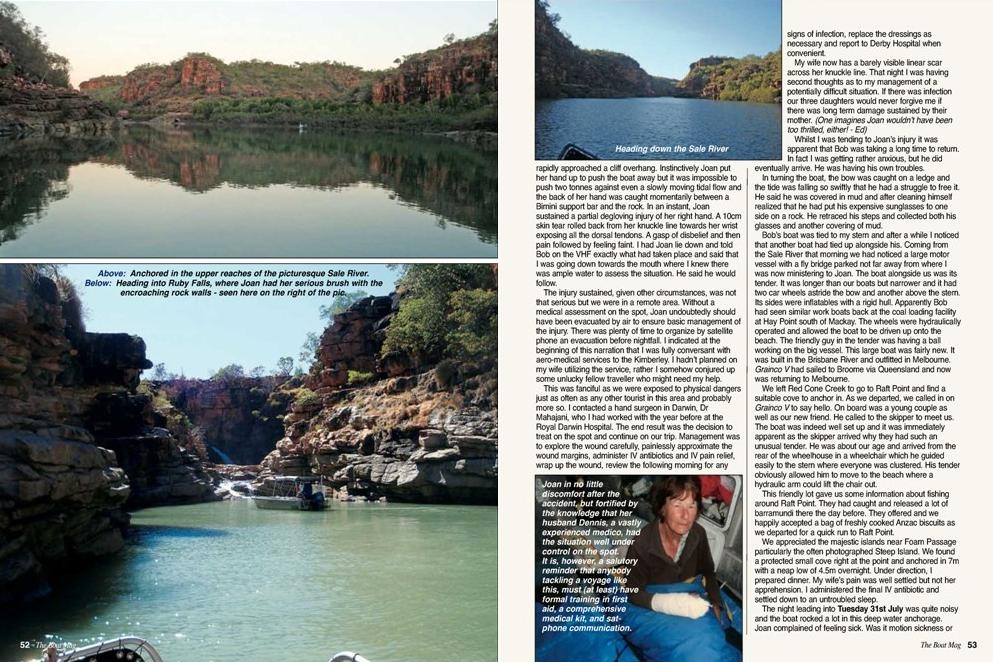
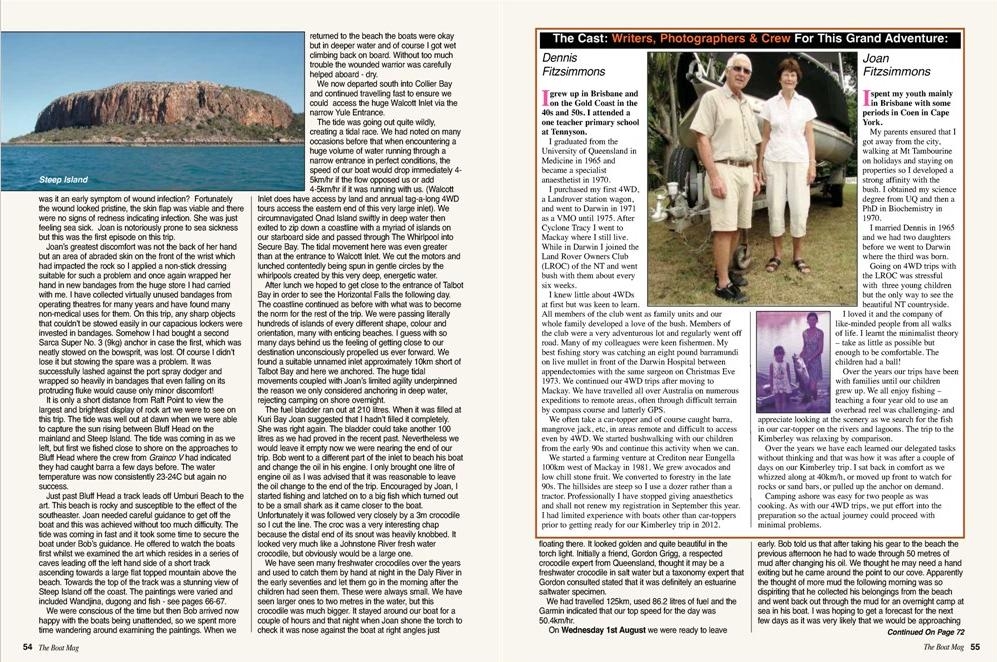
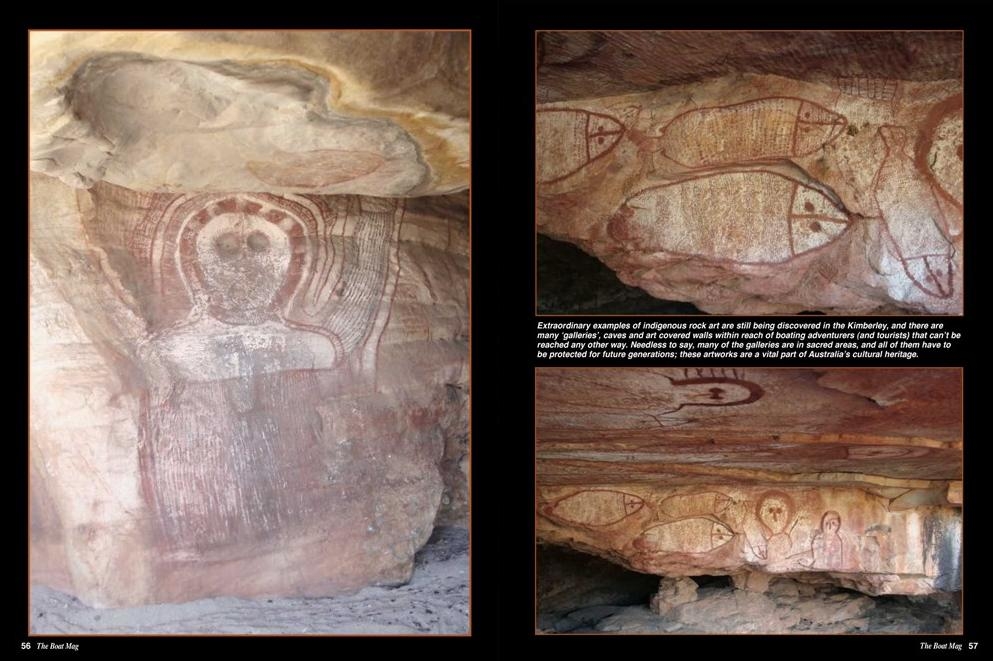
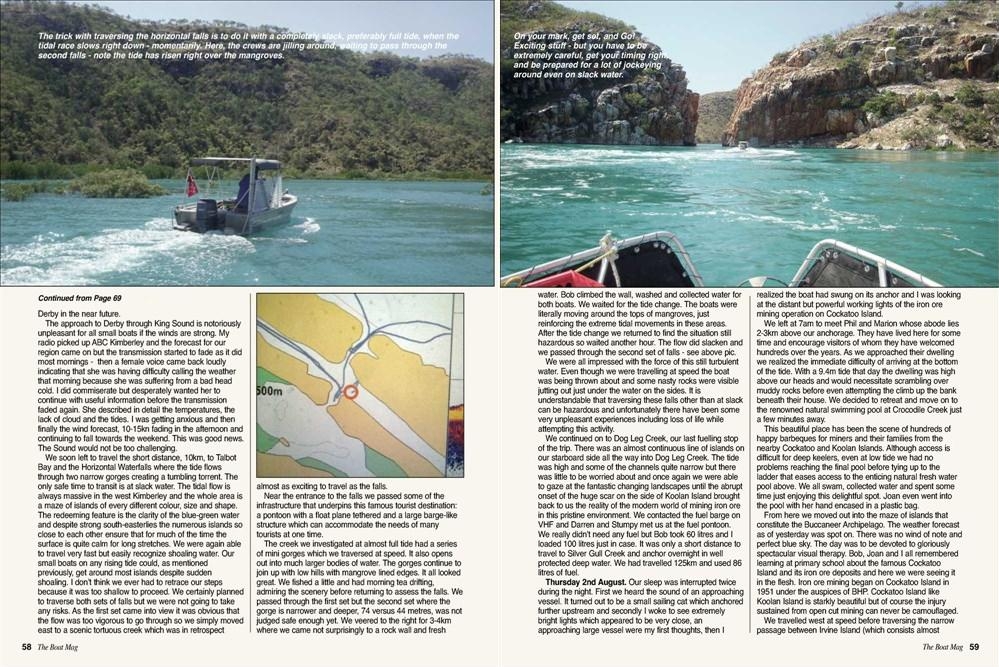
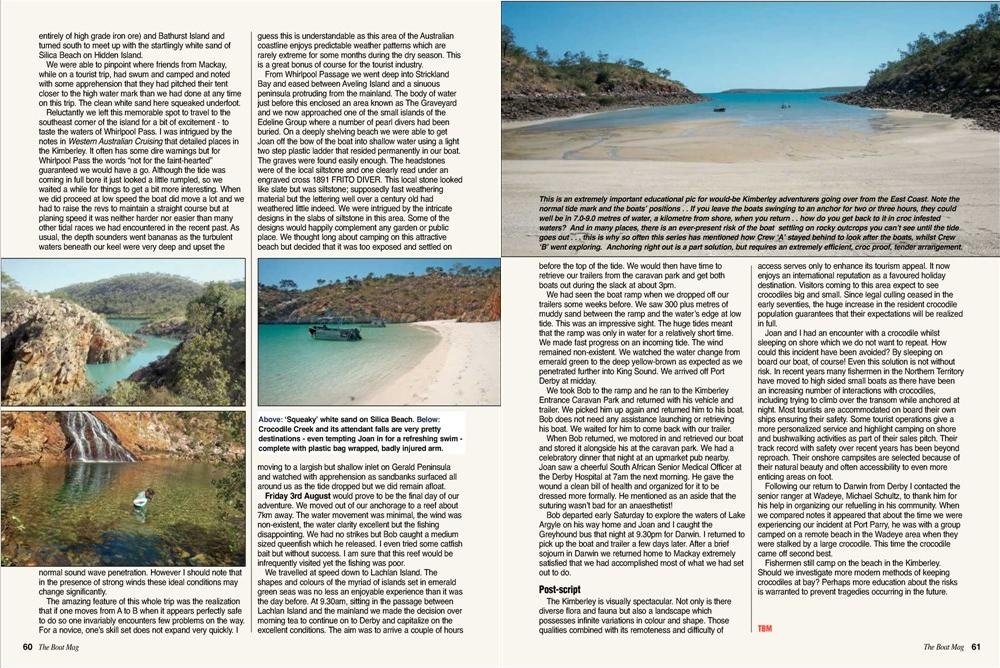
For further information,
please call
Mike Jessop, Oceancraft
Phone (07) 5499 6937
Email:
mike[AT]oceancraft.com.au
Web Site
www.oceancraft.com.au
Click here to contact the sales office via E-mail
Web: www.oceancraft.com.au
Click here to
order request price quotation
or press the back button on your browser
Click here to go to the home page or press the back button on your browser
Since the recent decision to hold over the extremely controversial Browse LNG Project on and offshore from the Kimberley Coast, this Exceptional ancient land has won a: timely reprieve. For Dennis and Joan Fitzsimmons, fresh from an amazing journey where few people / will ever go, this was the news they wanted to hear. More than most, they KNOW what is at stake: they've just been there on Thursday 14th June 2012 two 6.0 metre open aluminium boats left safe haven of Tipperary Waters Marina in Darwin to begin the journey to Derby on the western Kimberley coast. Some 51 days and just over 4,100km later after hugging the coast line and investigating where practicable rivers, creek and bays that were deemed interesting en route, the boats arrived off the public boat ramp at Derby on Friday 3rd August 2012 My wife Joan and I were in one boat and Bob was the sole occupant of the other. Being older but still bold we have learned from previous endeavours to plan ahead carefully. Small boat handling demands some physical effort and as the length of the trip was considerable, the areas to be traversed remote, we hoped our forward planning would keep our personal discomfort to a minimum. We were all in reasonable physical health but despite friends referring to our forthcoming adventure as "that suicide mission" we all thought that our mental health was okay as well. It is true to say that the overwhelming majority of friends when acquainted with the details of the trip, expressed interest in both its planning and outcome. They often gave very useful advice but showed no Inclination to join us. Why?Why did we decide to travel this section of the Coastline in such a small boat? Qver a lifetime exploring Australia by vehicle and on foot we had been unable to access most areas of the Kimberley Coast by land. This area has always been considered remote. In practical terms it is most easily visited by sea. When?
Some 5 years ago we made the decision to visit the Kimberley Caost by boat. Initially we contemplated using just one boat but quickly realized two smaller boats, by providing greater versatility, would The scale and scope of this voyage is astonishing - especially by (say) European standards, where journeys of this length could involve passing around several countries. What is also critical to understand is that for hundreds of miles there most likely isn't any civilisation or back-up if things go pear shaped. An increasing number of resorts and commercial enterprises (e.g. pearl farming) however, are making things much safer than they've ever been, but this is still a harsh, unforgiving environment. be the better option. In 2010 we gave ourselves the deadline of undertaking the trip in the dry season of 2012.
For me, 2011 would be spent juggling work commitments with all the activities necessary to ensure that the trip would be successful. Adverse weather conditions can make any boating activity hazardous. The predictability of the weather pattern in the northern Australia dry season makes small boat activities safer than at any other time of the year.
During the dry season the days tend to be warm to hot and the nights cool to cold, particularly if one is significantly inland. It rarely rains and the skies are usually cloudless. The most important weather characteristic for boats is the wind patterns. The prevailing winds are east to south easterlies at 10 to 15 knots. Around the Kimberley coast they often fall much lower for brief periods but of course sustained winds in excess of 25kn for a few days are well within normal limits.
In general it is easier for small boats to travel down wind so beginning the trip from Darwin and then travelling west seemed the most prudent way to go. Planning The preparation for any long trip requires time and effort. There are a host of things to do before one gets to the start line. Some activities are more pressing than others. Prioritising is essential. I had very limited experience in handling and navigating small boats in coastal waters prior to this trip.
This was to cause considerable anxiety for me and only dissipated as the trip itself progressed. Other tasks such as provisioning and organizing camping requirements provoked little anxiety as we were very familiar with them and were accomplished with minimal time and effort. Boat Choice By far the most important single activity was acquiring a suitable boat and motor. The boat had to be capable of allowing us to handle coastal waters with equanimity but Dennis Fitzsimmons I grew up in Brisbane and on the Gold Coast in the 40s and 5Os. I attended a one teacher primary school at Tennyson. I graduated from the University of Queensland in Medicine in 1965 and became a specialist anaesthetist in 1970. I purchased my first 4WD, a LandRover station wagon. and went to Darwin in 1971 as a VMO until 1975. After Cyclone Tracy I went to Mackay where I still live. While in Darwin I joined the Land Rover Owners Club (LROC) of the NT and went bush with them about every six weeks.
I knew little about 4WDs at first but was keen to learn. All members of the club went as family units and our whole family developed a love of the bush. Members of the club were a very adventurous lot and regularly went off road. Many of my colleagues were keen fishermen. My best fishing story was catching an eight pound barramundi on live mullet in front of the Darwin Hospital between appendectomies with the same surgeon on Christmas Eve 1973. We continued our 4WD trips after moving to Mackay. We have travelled all over Australia on numerous expeditions to remote areas, often through difficult terrain by compass course and latterly GPS. We often take a car-topper and of course caught barra mangrove jack etc. in areas remote and difficult to access even by 4WD. We started bushwalking with our children from the early 90s and continue this activity when we can. We started a farming venture at Crediton near Eungella 100km west of Mackay in 1981. We grew avocados and low chill stone fruit. We converted to forestry in the late 90s. The hillsides are steep so I use a dozer rather than a tractor. Professionally I have stopped giving anaesthetics and shall not renew my registration in September this year. I had limited experience with boats other than car-toppers prior to getting ready for our Kimberley trip in 2012. Joan Fitzsimmons I spent my youth mainly in Brisbane with some periods in Coen in Cape York. My parents ensured that I got away from the city. walking at Mt Tambourine on holidays and staying on properties so I developed a strong affinity with the hush. I obtained my science degree from UQ and then a PhD in Biochemistry in 1970. I married Dennis in 1965 and we had two daughters before we went to Darwin where the third was born. Going on 4WD trips with the LROC was stressful with three young children hut the only way to see the beautiful NT countryside. I loved it and the company of like-minded people from all walks of life. I learnt the minimalist theory take as little as possible but enough to be comfortable. The children had a ball! Over the years our trips have been with families until our children grew up. We all enjoy fishing teaching a four year old to use an overhead reel was challenging- and appreciate looking at the scenery as we search for the fish in our car-topper on the rivers and lagoons. The trip to the Kimberley was relaxing by comparison. Over the years we have each learned our delegated tasks without thinking and that was how it was after a couple of days on our Kimberley trip. I sat back in comfort as we whizzed along at 40km/h. or moved up front to watch for rocks or sand bars, or pulled tip the anchor on demand. Camping ashore was easy for two people as was cooking. As with our 4WD trips, we put effort into the preparation so the actual journey could proceed with minimal problems. nimble enough to investigate very shallow awkward and often muddy waters with aplomb. Obviously the choice had to be a compromise between a car-topper and a boat able to handle conditions off shore. The proposed boat had to carry two people with all their gear for approximately two months with minimal support en route. We quickly realized that after scouring the literature both on and off line there was little evidence of trips similar to the one we hoped to make. Early in 2011 I came upon a boat with a non- conventional configuration, a boat which claimed to incorporate most of the good qualities of current inflatables but at the same time minimising some of their inherent disadvantages in northern waters. A yachting friend in Darwin, Paul Zlotkowski, used such a boat as the tender for his 65 toot sailing cat. He thought that an appropriately modified larger version would be an ideal compromise for an inexperienced boater like me. The boat design makes it extremely buoyant and it can handle awkward seas easily. It is more resistant than inflatables to both the relentless effects of the tropical sun and impacts against hard and sharp objects such as rocks. Very importantly, it could be designed so as to incorporate very generous sealed storage capacity, uncluttered adequate deck space and a hull of significant inherent strength. "By the time we started the trip in 2012 we had organized reliable fuel sources at seven locations between Darwin and Derby. . ." In July 2011 I asked Mike Jessop from Ocean Craft in Caloundra in Queensland to build such a boat for me. Although there are other manufacturers of boats of similar design in Australia and New Zealand, I would agree with Mike that his aluminium version replicates a good quality inflatable very closely. As the boat was being built I was finalising a suitable power source. The motor was going to be an outboard. Again, the literature is replete with the comparisons between modern four and two stroke motors. All modem motors are very reliable and much more fuel efficient than their predecessors. For the proposed Mike Jessop's 6.Om Ocean Craft aluminium inflatable style craft proved ideal for this extreme adventure, although it was never going to work with the single Suzuki 90 they planned for the one tonne load of fuel, people and gear needed for the voyage. It only came together when Reef Marine upgraded the rig to twin Yamaha 70s. journey, fuel efficiency was going to be a significant factor. I decided in favour of a four stroke primarily because they are probably more fuel efficient despite being heavier and more complex than the two stroke equivalent. The second generation Suzuki 9Ohp four stroke seemed a good choice and I opted for this motor with a 6hp four stroke auxiliary of the same make. I had examined the 8hp model which is quieter, twin cylinder versus single, but I couldn't lift it and as I would be using it on my car-topper as well, the 6hp was the more realistic choice.
Fuel Issues In parallel with acquiring a suitable boat and motor the challenge of supplying the boats with enough fuel for the trip occupied significant time and effort. In the past it has been much easier to gain access to reliable diesel supplies than petrol in remote areas. From the beginning we attempted to plan fuel pit stops at such intervals that on arrival at each stop we would still have some fuel in reserve to cover unexpected contingencies. Initially this forward planning plunged me into despair. Outboard fuel was infrequently available in some areas. However as the year 2011 progressed, our enquiries met with increasing success. During 2012, two new resorts would be opening on the Kimberley coast. We would be able to access fuel at both spots, but more importantly one was within a remote area that had stymied us from the beginning. We remain indebted to Paspaley Pearling Company for providing a solution to this problem. We were advised against dedicated fuel dumps because of security problems. We knew that in an emergency we could have fuel helicoptered to us. By the time we started the trip in 2012 we had organized reliable fuel sources at seven locations between Darwin and Derby. Route There are some 1540 nautical miles of coastline between Darwin and Derby. We hoped to average 6Onm daily. Some days we would be stationary, for example, awaiting refuelling in Timber Creek and Wyndham. At other times days were spent within river systems. Overall we averaged 50nm daily for the trip. Both boats had complete sets of nautical maps. I also had complete topographical maps. The big river systems are poorly outlined by nautical maps and chart plotters. The concepts of surrounding terrain are much more easily taken on board when viewing a large topographical map compared to the displays on hand held GPS units. It is not difficult these days to measure distance over ground very accurately with modern chart plotters. Probably upsetting to true sailors, the preferred unit of measurement for us was metric. We calculated fuel use and distance travelled as if travelling by car. It is obvious that even the modern maps have discrepancies when examining coastal regions in detail. The nautical maps frequently display areas through which one is proceeding as unsurveyed or only partially surveyed. Modern quality depth sounders ease the strain considerably by not only accurately recording the depth of water beneath the keel but give a good impression of the bottom as well. Being in a small boat makes navigating in such areas less stressful. I cannot emphasize too much the value of readily available good mud maps describing these blind spots in the Kimberley. The current edition of Western Australian Cruising edited by the Fremantle Sailing Club is almost essential reading for those venturing into the Kimberley for the first time. Road Transport Although we were going to travel some 4000 km over water on this trip, in fact we would be towing the boat almost twice that distance on land. Welcome to long distance boat trailer towing. Over a lifetime of travelling long distances with and without trailers, we were very much aware of the pitfalls. We virtually had no trouble coming and going from our home. Our vehicle, a LandCruiser Workmate Station Wagon had ample power to tow boat and trailer. The trailer was an "off the shelf" Redco Sportsman tandem axle, 14 inch wheels with mechanical over-ride actuated hydraulic disc brakes. The only modification specified was to have five leaves to each spring and each leaf was to be 8mm thick. We employed heavy duty 1500kg "truckie" ratchet tie-downs. The motors were supported by robust neoprene supports placed between the hydraulic tilt rams and the fixation points of motor to transom. All midline rollers had wooden blocks to support them if they sagged. The bimini and solar panel were folded down and supported as well as the boat being enveloped in an inexpensive cover whilst travelling long distances. The critical feature that underpins all long distance travelling is regular checking of all components. The tyres need to be assessed initially as they can heat excessively if they have inappropriate pressures. There must be minimal movement between boat and trailer at all times. Movement is usually well controlled after the first 100km or so. Modern LED lights have eased the burden of electrical failures. On our cambered highways we found that the off side wheel bearings occasionally needed adjusting. Living Conditions - On And Off The Boat My wife and I had to share the boat with at least a ton of gear. By far the heaviest component but the best stored was fuel. We were capable of storing approximately 700 litres of outboard fuel. Forward of the slimline central console was room for a 300 litre collapsible fuel bladder, manufactured locally by Liquid Containment. This bladder was restrained from moving v towards the bow by a robust spinning platform which also enveloped a 122 litre inbuilt fuel tank. In front of the spinning platform was the open anchor well which housed 18m of chain and 100m of 10mm anchor rope. Two 20 litre plastic jerry cans were lashed to the port splash covers. Very neatly placed in the stern was an inbuilt 244 litre fuel tank which did not intrude one inch into the generally uncluttered but generous deck space. The combined weight of everything else we took came to 369kg. All our food added up to less than 75kg excluding the contents of the fridge. Everything was stored in six large hatches which occupied all of the high wide side walls welded to the longitudinally arranged cylinders which in turn were welded to the 5mm thick deep V hull. These cylinders were broken into eight compartments of which four were permanently sealed with valves and four sealed with hatches. The hatched compartments nestled between twin sealed compartments meeting at the bow and the stern pair which protruded beyond the transom. The hull was sealed but like the decked area, was accessed by small drainage plugs. The deck area contained a removable Captain's Chair and two folding side bench seats. The starboard bench seat incorporated a removable chair which allowed the occupant to face forward whilst travelling. It was easy to place two full length thick self-inflating mattresses in parallel on the deck. As the trip progressed soft gear did gradually intrude on the deck space but never effected the sleeping arrangements. At no stage were we ever worried by even a small fuel leak. All gear ‘n the various hatches remained free of any salt water intrusion. Food preparation was handled both on and off the boat by employing very simple means. All heating on the boat was done utilizing the simplest butane cartridge gas burners that one sees piled high at every BCF outlet in Australia. We have used them for years and have found them very reliable and surprisingly robust. We spoilt ourselves by purchasing a new one including four cartridges for less than $25. Water was boiled both on the boat and onshore in an old stainless steel singing kettle with a heat resistant handle on top. A $10 non-stick pan from Coles proved invaluable for most of our cooking. We also had Joan's considerable experience as a bushwalker provided an invaluable background as she worked within the limitations of living aboard a tiny space for several months, organising the requisite 'three meals a day'. an excellent stainless steel billy. Onshore cooking was done on an open fire. A grate was used initially but soon discarded as unnecessary. Dry wood was always abundant and it took only seconds to light a fire. We took every opportunity to cook onshore. The basic food we brought was the usual stuff we carried when backpacking into remote areas, mostly dehydrated or freeze dried. I know such food may not taste great in the comfort of your home but it is amazing how the exertions of an arduous day consistently seem to enhance the taste of simple fare. We were not backpacking this time and we were able to bring along lots of things to enhance the enjoyment of our meals. Our 23 litre Waeco fridge/freezer kept a store of meat and vegetables which supplemented the diet for the first two weeks. We also added some perishables at Timber Creek and Wyndham. We had hoped to catch fish and alternate evening meals with our daily catch but although the fishing was poor throughout the trip we did manage to supplement many meals. Two identical AGM batteries supplied power for the boat. One was dedicated to the engines and the other, the house battery, provided power for all DC outlets. The batteries were connected in parallel and incorporated isolating switches and a dual sensing voltage sensitive relay (VSR). External charging of the house battery was from a 250 watt solar panel. Both batteries were located in the rear side wall port hatch. Camping on the beach and above the dunes was a simple affair. We again resorted to the tactics we employed whilst bushwalking but spoilt ourselves with generous pillows and the afore-mentioned self-inflating mattresses. In general we planned to make camp by 4pm each day. Searching for a suitable overnight campsite or anchorage was often time consuming and leaving it any later made detecting underwater obstacles that much harder. We had planned to camp on shore as much as possible. We knew that at times we would have to anchor in deep mangrove lined creeks. We had prepared for this by having a customised all enveloping mosquito/sandfly net. This could be erected quickly and stowed with equal alacrity. This net weighed 22kg and served very well on the surprisingly few occasions that we needed to use it. We both agreed that this was the most expensive mosquito net we would ever purchase. As the trip progressed the tides became much bigger as we approached Derby and it often became impractical to consider beach camping late in the afternoon. Sourcing fresh water can be a problem in the Kimberley but usually only late in the dry season. Our boat could carry up to 200 litres of fresh water but we never had more than l00 litres on board at any one time as we were able to replenish at irregular intervals throughout the trip. On many occasions large fresh water pools were found up major creeks and river systems above the tidal/non-tidal junctions. We often took the opportunity then to wash our clothes and ourselves as well as collect water. We used salt water when cleaning up after meals. It proved easy to throw out cutlery with the washing up water. The situation is easily retrieved on a beach but not on a boat. We were down to one fork between us by the end of the trip. We had ample fishing gear and invariably two loaded small rods were always kept safely tucked in against the base of the starboard spray dodger. Toilet arrangements on board were simple. A toilet seat was attached to a folding stool beneath which was placed a dedicated bucket. The seat and stool were stowed above the rear fuel tank completely out of harm's way. Safety First Shortly before we left Mackay to begin our trip Bob and I met up with the celebrated long distance single-handed power boat adventurer, Hans Tholstrup. At one stage he indicated the underlying philosophy that he had accepted was necessary to undertake his type of journeys "if you aren't prepared to put your life on the line don't go". We knew that our proposed journey would be challenging but hoped our forward planning, in conjunction with sensible appraisal of any given situation would ensure that we would not be putting our lives at risk. All boats travelling in open waters these days are required to comply with stringent safety standards. Both boats not only easily complied but expanded on these essentials. Each boat had a satellite telephone and our boat carried a personal epirb as well. I also brought two hand held 5 watt UHF radios that we use when on 4WD trips but after noticing the frequent use of hand held VHF by the tourist boats coordinating their tenders, especially ship to shore, perhaps VHF radios would have been a better choice but where does one draw the line between realistic use and costs? Bob had on board a hand operated desalinator which never left its original wrapping. Both boats carried comprehensive tool kits and an array of appropriate spare parts. (A comprehensive spares list for both motors, including two aluminium props, was prepared for me by Reef Marine. With the exception of a 1 litre container of engine oil, these were all returned unused to Reef Marine at the end of the trip.) Any problems that we could fix en route would have to be simple and thus our fixation on getting everything functioning perfectly before setting forth. My boat started with one chart plotter but ended up with three and two depth sounders by the time the trip commenced. We had an excellent medical kit and were familiar with the emergency services available to the people in the remote Kimberley region at this time of the year. Of course two boats travelling in tandem is a safety factor in itself. In comparison with all those brave sailors who explored and surveyed the northern coastline in the nineteenth and early twentieth centuries our journey would be far less perilous. Getting To The Start Line - In Slow Motion The boat and motor were first trialled in mid-October 2011. The boat was loaded with a tonne of water in a variety of containers including a wheelie bin. Joan and I was produced. Unfortunately, the trial did not include the weight load. Although Joan towed the boat back to Mackay in mid- December it was only in the New Year that we were able finally to familiarize ourselves with it. Initially, significant stress was endured whilst launching and retrieving from the large busy public ramp at Mackay Harbour. It can handle up to six boats simultaneously and was always very crowded but kind people often lent us a hand. Real stress was to come later. In mid-February we arranged to meet up with two much larger boats at Repulse Bay in the Whitsundays. It is approximately 45nm north of Mackay Harbour. Midway to our destination, the stainless steel propeller guard disintegrated and in the process modified the aluminium prop blades before the motor was stopped. The guard may have been loose before a large clump of seaweed caused it to malfunction. It was supposed to protect the blades from rocky bottoms in unsurveyed parts of the Kimberley. It was my idea but my boating friends had been sceptical of its worth. Actually it was worth $600 and would never be able to prove anything. We were going to live aboard one of the two large boats which were anchored in a mangrove lined creek. I was now able to trial our boat in shallow waters. Whilst following the tender of one of the bigger boats up a narrow creek which ended in fresh water I managed to modify the prop blades yet again, but this time on rocks. The situation was not irretrievable I watched my skilful friends remove, repair and replace the damaged prop now considered adequate for the return journey to Mackay. Unfortunately more significant concerns were brought to my attention. The consensus among these very capable boaties was that despite the damaged prop the boat was underperforming. They suggested that a different pitched prop may rectify the problem. After mulling over my friends' observations I started to have some doubts as to whether a pitch change would be the answer to my prayers. What I wanted to know was the actual hull weight of the boat with all its modifications. Sims Metal in Mackay kindly supplies a public weighbridge service. Often a gold coin donation for a local charity and a short wait at their convenience allows access. My computations put the hull weight at 788kg. The weight according to specifications was given as 450kg. I knew that final trialling in the previous November did not include the expected payload for the Kimberley trip. I now placed my boat in the capable hands of Greg Camilleri and Brett Griffin, co-owners of Reef Marine Mackay. Our boat had to be able to carry a payload of one tonne in the Kimberley. Despite pitch changes the boat remained basically a displacement hull when loaded with four adults and a tonne of sand and water. Then my boat underwent a metamorphosis. Some three weeks later, trialling with a similar load and twin 7Ohp four stroke Yamaha motors, the boat came through with flying colours. Not only was the performance more than adequate, the fuel consumption was considered excellent, 1 .2km / litre. This improved to 1 .43km / litre by the time we completed our trip. At this stage Joan unfortunately slipped in the kitchen and fractured her left wrist and the resultant awkward, above elbow cast, precluded any useful boating activities for the next seven weeks. We put the start date back by a month. One advantage of this time delay was to have the boat modified yet again. It was suggested to me that the supporting structure for the solar panel and the entire bimini itself wouldn't last the distance for our proposed trip. Paul, from Custom Unique Trimming Mackay, replaced both components which subsequently performed flawlessly. We did manage one extended trip before Joan's injury. We had excellent weather conditions and travelled almost 45nm directly east off shore from Mackay. The boat with its new motors handled easily, despite my inexperience with the twin throttles. More importantly, we were able to practice anchoring at a beach overnight with the boats going dry. Mackay has tides of six to seven metres, comparable to many areas on the proposed journey. The major difference is the significantly reduced likelihood of meeting a crocodile. We just managed to get our twenty hours up for our first motor service before we departed for Darwin on Thursday 31st May arriving three days later after an uneventful trip. Our immediate plans were very simple. Organize our admission to Tipperary Waters Marina. Transport our vehicles and trailers to Derby and return. Confirm all our fuel sources Complete loading of the boats and ensure that all equipment is functioning correctly before departure. Joan and I stayed with our daughter in Darwin whilst Bob opted to live aboard his boat in the marina. The day chosen to enter the marina coincided with the Transit of Venus and some friendly enthusiasts with elaborate equipment set up near the ramp allowed us to view the transit before launching our boat. Our two boats were to share a fifteen metre berth normally reserved for boats up to 60 feet in length. It was with some trepidation I faced the prospect of gently presenting the boat to the berth without damaging Bob's boat, neighbouring tall yachts and my dignity. It all went very well! The lock itself was far less intimidating than I had imagined. On Thursday 7th June our vehicles with trailers in tow slipped away for the long haul to Derby. On our way down we stayed overnight in Timber Creek and introduced ourselves to Neville Fogarty who runs a daily late afternoon tourist trip down the Victoria River from Big Horse Creek some ten km further west. The stunning scenery and the spectacular wildlife are ideally displayed at this time of day. Neville also offers fishing excursions and rents house-boats. We had arranged to tie up to his pontoon jetty in this creek and take on fuel during our trip. He was very friendly and importantly gave us a mud map of the river leading into Big Horse Creek. This was to prove useful in the not too distant future. In Derby we left both trailers and Bob's vehicle in Bayside Caravan Park in the capable hands of Ian and Jill, co-owners and managers who offered us very generous rates. Whilst in Derby we visited the public boat ramp and quickly appreciated the problems posed by accessing a ramp in an area which has the largest tides in Australia up to twelve metres. In strong winds, the waters leading into Derby, King Sound, are notoriously difficult for small boats. This and the strong currents might add an interesting twist to the retrieval of the boats at the end of our journey. Confirming all our fuel pit stops turned out to be very easy. Our forward planning which had consumed significant time and effort over the past year was now totally justified. In our absence the two "tinnies" had created significant interest from surrounding boaties. Bob found that many people approached him as he was working on his boat. They often imparted useful information relevant to our proposed journey and some gave us very useful mud maps. The grey nomads were dubbed "adventurers". Completing the loading of our boat did not take long. Most of the equipment was loaded in Mackay before we left. Fuel was not available at the marina. We decided to obtain fuel directly from the bowser at the public jetty in Cullen Bay, some ten minutes away by sea, on the day of departure. My immediate concern was an intermittent fault with the Humminbird chart plotter. It turned out to be an electrical connection but Michael Ede from Inboard and Outboard Marine Darwin was unhappy with its long term reliability and downloaded nautical maps of the required section of coastline onto our handheld GPS. In the marina, just before we left, Paul, who had recently sailed single-handed from Singapore to Darwin in a 50 foot Beneteau, told us that his only chart plotter was his iPad loaded with Navionics maps of Asia, South Africa and Australia. This stimulated us to download maps onto my iPad for Australia and New Zealand for about $49, considerably less than the $400 plus paid for Navionics Gold for the Humminbird. We were now going to start the trip with three chart plotters. Darwin to Wyndham via Timber Creek We left Darwin on Thursday 14th June. The departure started out well enough. The lockmaster Rodney "Rocket's Smith eased us out of the marina. It was a beautiful day with virtually no wind. However the marine petrol bowser at Cullen Bay sported an OUT OF ORDER sign. What to do next? Fortunately when researching fuel suppliers I had considered that Bailey's Marine Fuel Services could be helpful. They provide fuel for many outlets around the WA coastline. I had even done the Workplace Health and Safety Test in order to qualify for the safe usage of the company's fuel dispensers. We had also arranged an account with swipe card and pin number. Now, cap in hand, we would have to front the fuel depot at Fisherman's Wharf without organizing a time in advance. The wharf was sited quite close to the marina we had just vacated. Frantic phone calls were made to all who were arriving to see us oft at Cullen Bay and redirecting them We have never seen before nor since, so in any large crocodiles spaced so closely as we saw that day. We were definitely going to sleep on board tonight. to the alternative location. As expected, the wharf was a hive of activity with vessels of several hundred tonnes fuelling up. Ben, the manager, after scrutinizing all my documents, allowed us to proceed with the help of friends who were arriving from Cullen Bay. We needed help! The wharf is not conducive to small boats taking on fuel at low tide. Two people were required to man the pump and direct the fuel line down some four to five metres to our carefully aligned waiting boats. To add to our woes workmen arrived to undertake maintenance of the wharf below its deck. The sound of high pressure water hoses and jack hammers in the immediate vicinity did nothing to expedite the fuelling process. It took almost three quarters of an hour before we were able to depart the wharf as well as farewell friends and family. This rather inauspicious start was followed by a very enjoyable high speed run of almost one hundred kilometres to Bare Sand Island. This island is a renowned turtle nesting area and had a number of volunteers monitoring the current breeding season. It was also a former RAAF bomb practice range and signs still indicated the presence of unexploded bombs. We camped on the beach and during the night a turtle passed by one side of our tent to nest and returned to the sea via the other side. With the benefit of hindsight I now question the suitability of camping so close to the water on our first night out and of similarly placed campsites over the forthcoming weeks. It was noted at the time that the camp for the volunteers was sited well inland. On Friday 15th June we were hoping to reach the Daly River. On the way, a sea mist came in from the west. At times it was almost a complete white out. We even lost sight of Bob's boat ahead. The Peron Islands passed on our starboard side unnoticed except for their images on the chart plotter. Finding the mouth of the Daly was always difficult in the past but modern chart plotters make this a lot easier. We actually had lunch on a muddy bank near the mouth. Bare Sand Island was now one hundred and twenty kilometres behind us. Even though we stopped for only approximately an hour, the big tidal range meant constant attention to the anchoring points of the boats to the land. This was a procedure which would repeat itself over the forthcoming weeks. Travelling upstream against the tide we encountered many sandbanks. We had hoped to find a suitable beach and camp. This possibility was soon dismissed as unrealistic. We have never seen before nor since, so many large crocodiles spaced so closely as we saw that day. We were definitely going to sleep on board tonight. On the way upstream from the mouth I had observed what looked like a crab-pot float. We had seen no one and on our trip down stream when we saw it again went over to investigate more closely. The float turned out to be a ballasted buoy indicating that we were now at Port Daly. We had found the ideal tethering point for an overnight stay. With boats tied in series and our all- enveloping mosquito net in place we had an excellent night's sleep despite the raging tidal movements around us. Early Saturday 16th June saw us drifting slowly down through the mouth eating breakfast and fishing before striking out for Port Keats and then Wadeye, our first fuelling stop out of Darwin. Initially the seas were rougher than the day before and once again a mist came in from the west and again the boats lost sight of each other intermittently for the next hour or so. The coastline is very straight and despite the mist, with slight seas we were able to travel quickly down to Port Keats. As we had noted the day before, the coastline was more interesting and attractive than we had anticipated, with red and cream cliffs, sandy beaches and small rocky head lands. Wadeye is roughly eight kilometres up a winding creek and is a large aboriginal settlement on the western side of the Northern Territory. We were once again in an active mobile phone area (Telstra) so contacted the head ranger, Michael Schultz, to confirm the availability of fuel on the following Monday the local service station is not open on weekends. He had arranged for a friend to drive down to the Wadeye jetty (pictured above) in order to ferry our fuel drums the three hundred metres to the service station at 9.30am. The timing was important as there is a significant rock bar across the creek which is only passable two hours either side of the top of the tide. Earlier Michael had kindly emailed the coordinates of the rock bar to us. The ranger indicated that the elders were not aware of our presence and probably would not welcome us arriving unannounced on nearby Docherty Island. A recent death nearby precluded the mainland beaches for camping until the "sorry business" was completed. He suggested that we anchor overnight in one of the numerous creeks nearby. We anchored in Mairmull Creek. The sandflies and mosquitoes were vicious at sunset and once again we erected our efficient mosquito net. We were now adjusting to what we expected would become the norm for the whole trip. There was a significant diurnal temperature variation. The days were never very hot and when travelling fast, as we often did off shore, a windcheater, usually a raincoat, was necessary as it quickly became very cold even in the absence of any spray. The nights were always cool and more often than not, cold. We often crept thankfully into our sleeping bags despite the warmth of a fire if we were on shore. If there was no significant breeze during the night then invariably whether on shore or on the boat, heavy dew settled on everything not under shelter. Needless to say, the water temperature, although not subject to as much variation as the ambient temperature, was consistently low reaching 17 C at times. We would regularly use these low temperatures to explain and excuse our meagre catches from casting lures throughout the trip. Monday 18th June arrived but not before we had left our mangrove creek site of Saturday for a more pleasant beach camp on a nearby small unnamed island. The refuelling went without too much stress. Cathy picked us up in her LandCruiser ute and drove Joan and me up to the service station while Bob minded the boats. It was a hive of activity at the station with many trucks lined up for fuel. Fortunately Cathy was able to get us to the bowser very quickly but when we went to pay in cash as we had been asked to do there was a hiccup. No cash was acceptable as there had been a break-in over the week-end and the cash register was being examined by immaculately dressed police. Payment was promptly dealt with by credit card and we were on our way back to the boats. The jetty and The days were never very hot and when travelling fast, as we often did offshore, a windcheater, usually a raincoat, was necessary as it quickly became very cold even in the absence of any spray. The nights were always cool and more often than not, cold. We often crept thankfully into our sleeping bags despite the warmth of a fire if we were on shore. surrounds at Wadeye are picturesque, but in practical terms a little difficult for small boats. We loaded the boats in turn, Bob's at the ramp because the tide had fallen too much to be safe at the Jetty. We thanked Cathy profusely and set off downstream. The tide had been falling for some time but any anxiety about the rock bar evaporated as we raced back down the creek past the danger zone towards the open sea. To our dismay huge sand bars appeared to extend even beyond the horizon in all directions. On what sea we could visualize, whitecaps confirmed the forecast of strong winds. We weren't going anywhere soon. Finally, with the winds abating, we left on Wednesday 20th June after a further two nights on our unnamed island. We were hoping to reach the Fitzmaurice River within two days but realized that it was a long way to go. We travelled at speed rarely more than half a kilometre off shore and then only to escape from breaking reefs extending out from small peninsulas which protruded from a coastline which almost exactly paralleled our course due south. We overnighted at Catfish Creek near Pearce Point ready for an early morning dash into the Fitzmaurice River. The evening before we had dined on the first of only three mud crabs that we caught on the whole trip. (June and July do not have "r" in theme). Joan and I were particularly interested in the Fitzmaurice River as we were last there in 1975 when four families scrub bashed in from Bradshaw Station homestead which is situated on the Angalari River a short distance upstream from its junction with the Victoria River. We were all members of the Landrover Owners Club of the NT and had planned the trip before Cyclone Tracy. We aimed to reach the tidal/non-tidal junction of the river because in our experience this was the most productive area for barra fishing in the dry season. In fact our eldest daughter caught a barra almost as big as herself. We reached the Fitzmaurice River early on Thursday 21st June on a rising tide. The mouth had eluded us in 1975, but it was as we expected wide and brown with towering hills in the middle distance but lined by lower jagged cliffs interspersed with heavily grassed plains. As we progressed up the river, a long, high ridgeline approached the river at right angles on both banks, and forced deep muddy waters to race through a short narrow gorge. We stopped for morning tea in a creek on the northern bank on a full tide. We could step easily from boat to grassy shore with an immediate drop off of 8.Om. We then attempted to reach our old campsite of yesteryear but a very extensive rock bar combined wh a falling tide forced us to do an about turn some ten kilometres short of our objective. The falling tide exposed rocky sandbanks typical of these rivers. With both motors raised we allowed the tide to direct us between sandbanks for some time before we dared to lower them and very cautiously move under power into what were obviously deeper waters. That day we broke our golden rule about camping for the night for the first and fortunately only time on the trip. "Prepare to make camp around 4pm whilst there is ample light". We anchored at 7.30pm that night. The advantages of modern technology came to the fore that day. With the deepening shadows we retraced our steps of the morning with ever increasing speed as we headed downstream directly west into a rapidly approaching sunset. Our 'breadcrumb trail' from the way up was followed meticulously on the way down in known and proven deep water. We knew that there was possibly good anchorage in a creek on the northern bank some eleven kilometres upstream from the mouth. This would make tackling the Victoria River much easier on the following morning. We anchored in 8.Om of water near low tide in a narrow creek with forested cliffs lining the banks. What we hadn't realized was that the narrow creek broadened out within 50m into a huge, wide, almost second arm of the Fitzmaurice River. At 2am we were woken by the boat oscillating quite quickly over a 40 degree arc on the bow anchor with the accompanying sounds one usually associates with rapids. The GPS confirmed that our SARCA Super anchor had not shifted and that there was ample water, 6m or so, beneath our keel. A glance at the typographical map explained our predicament and I cautiously let out more anchor rope and both the noise and the gyrations of the bow diminished appreciably. It was cold and pitch black. Torchlight confirmed the presence of boiling water surrounding our boat. With some trepidation I now faced the prospect of a potentially difficult anchor retrieval after first light. Suffice to say I learned a great deal but finally managed to stow the anchor after about seventy minutes of mainly inefficient and exhausting work. That morning, Friday 22nd June, we planned to travel up the Victoria River. This south-eastern corner of the Joseph Bonaparte Gulf is remote with virtually no permanent residents. Much the same obtained when the early surveyors arrived in the nineteenth century but of course there would have been a strong aboriginal presence, often unseen. It was difficult to obtain first-hand knowledge about the lower reaches of this large and long river, by far the biggest in the Northern Territory. I was able to talk to a person who regularly (twice a year) travelled down to the mouth from Timber Creek and camped for a week or so fishing. He chose to move up and down the river on neap tides but indicated that professional fishermen had in the past utilized spring tides and travelled long distances quickly by taking advantage of the ten knot tidal flow. However he warned that some spring tides began with a tidal bore of a metre or so in the lower reaches. The entrances to the Fitzmaurice and Victoria Rivers are almost contiguous. The spring tide allowed us to travel at speed from one to the other through a narrow channel between the mainland and Clump and Driftwood Islands. The tide was reaching well up into the foliage of the mangroves lining both sides of the passage. Such a sight usually indicated sufficient deep water for small boats to travel fast. The clarity of the water was excellent at this stage assisting such speeds. However, as expected, the waters rapidly muddied as we entered the true river but the depth sounders continued to indicate huge depths beneath our keel. limber Creek is approximately 170 km upstream from the mouth. We pushed on so quickly on this high tide that we got to within 50km of our destination before the tide ran out and our anxiety overwhelmed us. The scenery paralleled that which we had seen the day before in the Fitzmaurice but this huge river added many variations. We anchored in the Baines River a kilometre from its junction with the Victoria with sufficient water beneath our keel to stay afloat during the night and in such a position that any tidal wave would, we hoped, have minimal effect. Saturday 23rd June. As mentioned previously, when we were last in Timber Creek we were given a mud map detailing the safe route along the last fifty or so kilometres leading into Timber Creek. Bob left early to fish and when we attempted to join him we noticed a significant problem had developed with our VHF radio. Unless the squelch was turned up we could not receive and the associated noise was almost unbearable when travelling slowly. This coincided at a point where the river was very wide and shallow. Finding the channel was difficult. We saw other boats and people for the first time since leaving Darwin and were amazed that some were standing on a sandbank and some in water fishing in this crocodile infested river. After catching up with Bob we used the mud map to negotiate our way. It proved to be a great help and gave precise instructions about sandbanks and rocks and how to circumvent these dangers. The aptly named Skeg Rock had been the downfall of fishermen in the past. This whole stretch of the river below Timber Creek is very popular with both tourists and fishermen hence the excellent public boat ramp at Big Horse Creek some ten kilometres downstream from the town. Neville Fogarty has a pontoon at this creek and we planned to tie up to it and await refuelling on the following morning. At 10.30 am on Sunday 24th June we took on board 431 litres of fuel. We had now travelled 937 km since leaving Darwin. Neville kindly took both men back to Timber Creek where we purchased some provisions and made phone calls then returned me to the pontoon. Joan and I walked the low mountain range that runs parallel to the river behind the camping ground at Big Horse Creek. It gives a great overview of the surrounding country and one can just get a glimpse of the new bridge over the Victoria River that allows restricted entry to the Bradshaw Field Training Area. This bridge allows an unrestricted view up and down the river. We left Big Horse Creek pontoon early on Monday 25th June and of course, used the mud map as before. We called on Carmel and Trevor Parson, the caretakers at Bradshaw Station now under the control of the defence force since 1996. We anchored and tethered the boats with some difficulty at the ramp that services the homestead on the Angalari River and walked about a kilometre to a very friendly greeting and morning tea. The then modern homestead of 1975 had unfortunately been demolished by termites and the swimming pool, a luxury in those days, lay empty not because of any defect, but because when filled it was impossible to keep it free of cane toads which have become a serious problem in the Northern Territory in recent years. The original nineteenth century homestead has been heritage listed and Trevor showed us over resurrected remnants. Certainly life was hard here as it was in many rural backblocks. We noted some original cypress pine beams in the building, one of the few timbers in Australia naturally resistant to northern termites. When Trevor drove us back to the patiently waiting boats they were fortunately still easily accessible from shore we were getting this anchoring business right' Neville Fogarty has a large pontoon anchored at the junction of the Angalari and Victoria Rivers. We enjoyed a leisurely lunch while tied to ‘t and then moved downstream to Curiosity Peak for an overnight camp site. We were just below the Baines River in which we had anchored on the way up and opposite Mosquito Flats. The shallow areas which had been so confronting previously were under a higher tide and presented no difficulty. We were hoping to complete passage of the river on the following day Tuesday 26th June and gain entrance to the Joseph Bonaparte Gulf once again. During the night we noted tidal changes that are so typical of most large river systems in the north-western areas of Australia. There appeared to be little or no movement of tide for long periods. From a ridgeline immediately behind our camp site daylight exposed a river which appeared to consist of a series of sandbanks extending over to the very distant opposite shore and the tide was still falling. Tidal charts give reasonable accuracy in the lower reaches but become at times difficult to interpret in the upper reaches. At 8.0 am we moved very cautiously down-stream in very shallow water until we encountered much deeper water with a tide that must have been coming in a long time before we departed our camp site that morning. We now appreciated the conditions we could expect to confront us in the upper reaches of other river systems in the days ahead. Next Month: Dennis and Joan run down to Wyndham through the Cambridge Gulf (above), then come back to the picturesque Lyne River, before heading west-about the coast again, entering the spectacular reaches of the Berkely River and findi. . . but hey, we can't give it all away, can we? Just make sure you've ordered the next issue so you can follow their voyage and multiple discoveries, en-route to Derby in WA.